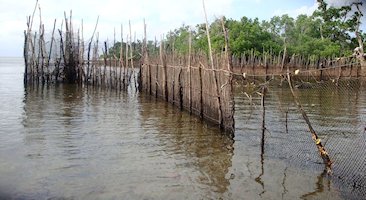
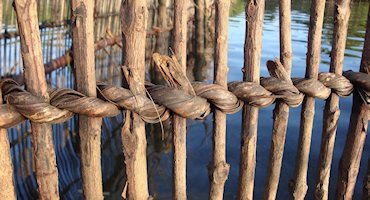
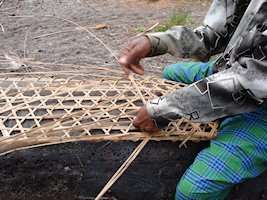
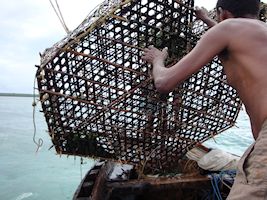


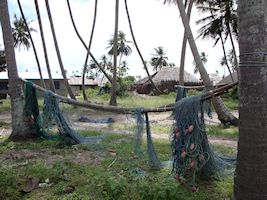
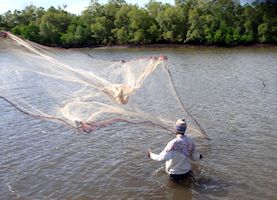
Classical, Arabic, Chinese and Portuguese accounts provide relatively rich descriptions of the East African coast, its inhabitants and their economic activities since the 1st century CE. Fishing, however, is rarely mentioned, as it must have been too mundane for special consideration. The mid-1st century Periplus Maris Erythraei usefully describes the canoes and fish traps that were commonly used: 'The [Menuthias, probably Pemba] island has sewn boats and dugout canoes that are used for fishing and catching turtles. The inhabitants of this island also have their own way of going after these with baskets, which they lower instead of nets around the mouths of [? rocky inlets]' (Casson 1989, 59–60). Interestingly, a type of fish trap known as mgono – a conical basket with a spring entrance placed in the channel between breakers – was still in use on Pemba in the 1920s (Ingrams 1924; 1931, 300).
Masudi, who visited the Swahili coast in 916 CE, recorded that 'there are many kinds of fish with all sorts of shapes' and describes using boats and harpoons to hunt for fish that apparently digest ambergris (Freeman-Grenville 1962, 14). Idrisi, in the mid-12th century, noted that at nearby Malindi, the inhabitants 'obtain various kinds of fish from the sea, which they cure and sell (Freeman-Grenville 1962, 20). Ibn Battuta, who visited East Africa in 1332, left a detailed account of a meal he enjoyed in Mogadishu, which included a large dish of rice, and side-dishes of chicken, meat, fish and vegetable stew (Freeman-Grenville 1962, 29), suggesting that fish was often eaten as part of a mixed diet. In Mombasa he notes that the greater part of the local diet consists of bananas and fish (Freeman-Grenville 1962, 31), and that locals import their grain from the Swahili, by which is probably meant the trade of rice from Pemba. The Chinese record that horses at Molin (possibly Malindi) were fed dried fish (Filesi 1972, 19) in the 8th century. A 15th-century writer, Fei Xin, who was well-informed from the Chinese naval expeditions to East Africa recorded at Mogadishu, describes fishing with nets, and feeding dried fish to domestic stock (Filesi 1972, 36-40; Snow 1988, 26).
The only detailed ethnographic account of fishing practices recorded before the introduction of modern fishing methods was undertaken in the Bajun islands in southern Somalia during the late 1940s (Grotenelli 1955). The account includes several chapters on economic activities and techniques around the Kenya–Somalia border, and describes the principal fishing methods and the crafts for constructing fishing gear and vessels. These generally concur with the evidence from the Lamu archipelago, where Prins (1965) included a description of fishing methods in relation to the types of vessels and number of crew involved. In 1987, the Shanga project recorded how fish were caught and the fishing areas where they were found, along with the collection of fish species, which form the basis of the comparative collection in the National Museum of Kenya (Horton 1996, 382-3). This showed that fish were collected from a wide range of habitats – coral reefs, estuarine, mangrove swamps and offshore – using a variety of techniques – handlines, gillnets, cast nets, traps, spears, bottom trawls and occasionally longlines.








Further south, there has been much less systematic recording of fishing techniques. W.H. Ingrams (1931), a colonial officer, was particularly interested in the shapes of fish traps on Zanzibar, types of sailing vessels and the rituals associated with fishing. Quintana Morales (2013a) undertook ethnographic fieldwork in the area around Vanga, during which she recorded the spatial distribution of fish consumption activities and the diversity of fishing methods (Figure 2). Other recent research has been related to debates about sustainable fishing on the coast. Glaesel (1997) divides traditional fishing gear into two categories: environmentally sustainable (hook and line, basket traps) and unsustainable (harpooning, fence traps, gleaning, poisoning), noting that sustainable methods have endured longer. Newer methods tend to be unsustainable (synthetic nets, spear guns). Studies of modern fishing methods include those on the coast of Kenya (e.g. Samoilys et al. 2011; McClanahan and Mangi 2004) and Tanzania (e.g. Darwall 1996). An important study is that of Nakamura (2011), which divides the aquatic regions around Kilwa Island into 'ecological zones'. He associates these zones with distinct sets of resources and fishing strategies in order to understand the mechanisms of fishing practices connected to both social and ecological factors. We take a similar approach in our comparison of exploited aquatic habitats around past Swahili settlements.